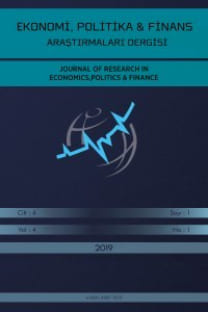Paranın Yansızlığı Hipotezinin Orta Doğu Ülkeleri İçin Test Edilmesi
Paranın Yansızlığı Hipotezi, iktisatçılar arasında geniş destek gören görüşlerden biridir. Bu görüşe göre, para arzındaki beklenmeyen ve sürekli bir değişimin uzun dönemde reel GSYİH üzerinde hiçbir etkisi yoktur. Bu da para politikalarının etkin olmadığı anlamına gelmektedir. Bu çalışma seçilen 12 ülke için 1980-2015 verileri kullanılarak yapılan analizle Paranın Yansızlığı Hipotezinin test etmeyi amaçlamaktadır. Elde edilen sonuçlar, seçilen ülkelerde paranın yansız olduğunu ortaya koymaktadır.
Anahtar Kelimeler:
Paranın Yansızlığı Hipotezi, Eşbütünleşme, Panel Veri
Testing the Money Neutrality Hypothesis in the Middle Eastern Countries
The Money Neutrality Hypothesis is a widely supported view among economists. According to this view, unexpected and permanent change on money supply, has no effect on real GDP in the long run. That refers to ineffectiveness of monetary policy. The aim of this study is to test the Neutrality of Money Hypothesis for 12 countries by using 1980-2015 data. The results obtained from tests implies that neutrality of money hypothesis accepted for selected countries.
Keywords:
The Neutrality of Money Hypothesis, Cointegration, Panel Data,
___
- Abouwafia, H. E. and Chambers, M. J. (2015). Monetary Policy, Exchange Rates and Stock Prices in the Middle East Region. International Review of Financial Analysis 37: 14-28.
- Bae, S., Jensen, M. and Murdock S. (2005). Long-run Neutrality in a Fractionally Integrated Model. Journal of Macroeconomics 27: 257-274.
- Coe, P. J. and Nason, J. M. (2004). Long-Run Monetary Neutrality and Long-Horizon Regressions. Journal of Applied Econometrics 19(3): 355-373.
- Fisher, M. E. and Seater, J. J. (1993). Long-run Neutrality and Superneutrality in an ARIMA Framework. American Economic Review 83: 402-415.
- Geweke, J. (1986). The Superneutrality of Money in the United States: An Interpretation of the Evidence. Econometrica 54: 1-21.
- Granger, C. W. and Newbold, P. (1974). Spurious Regressions in Econometrics. Journal of Econometrics 2(2): 111-120.
- Hiscock, R. and Handa, J. (2013). Long-run Neutrality and Superneutrality of Money in South American Economies. Applied Financial Economics 23(9): 739-747.
- Im, K. S., Pesaran, M. H., and Shin, Y. (2003). Testing for Unit Roots in Heterogeneous Panels. Journal of Econometrics 115(1): 53-74.
- King, R. G. and Watson, M. W. (1992). Testing Long-run Neutrality, National Bureau of Economic Research Working Paper No. 4156.
- Leong, K. and McAleer, M. (2000). Testing Long-run Neutrality using Intra-year Data. Applied Economics 32(1): 25-37.
- Levin, A., Lin, C. F. and Chu, C. S. J. (2002). Unit Root Tests in Panel Data: Asymptotic and Finite-Sample Properties. Journal of Econometrics 108(1): 1-24.
- Lucas, R. (1980). Two Illustrations of the Quantity Theory of Money. American Economic Review 70: 1005-1014
- Mills, T. C. (1982). Signal Extraction and Two Illustrations of the Quantity Theory. American Economic Review 72(5): 1162-1168.
- Noriega, A. E. (2004). Long-Run Monetary Neutrality and the Unit-Root Hypothesis: Further International Evidence. North American Journal of Economics and Finance 15: 179-197.
- Pedroni, P. (1999). Critical Values for Cointegration Tests in Heterogeneous Panels with Multiple Regressors. Oxford Bulletin of Economics and Statistics 61(S1): 653-670.
- Rahman, J. and Toyoda, T. (2008). An Empirical Study on Long-Run Neutrality of Money in the Japanese Economy. Japanese Economy 35(3): 87-117.
- Sülkü, S. N. (2011). Testing the Long Run Neutrality of Money in a Developing Country: Evidence from Turkey. Journal of Applied Economics and Business Research 1(2): 65-74.
- Tawadros, G. B. (2007). Testing the Hypothesis of Long-run Money Neutrality in the Middle East. Journal of Economic Studies 34(1): 13-28.
- Tuğcu, C. T. (2015). Paranın Yansızlığı Hipotezinin Testi: Türkiye Ekonomisi İçin Yapısal Kırılmalı Eşbütünleşme Analizi. İktisat Politikaları Araştırmaları Dergisi 2(1): 17-31.
- Westerlund, J. and Costantini, M. (2009). Panel Cointegration and the Neutrality of Money. Empirical Economics 36(1): 1-26.
- Yayın Aralığı: Yılda 4 Sayı
- Başlangıç: 2016
- Yayıncı: Ersan ERSOY
